By Jeremy Cox
Bay Journal
The Chesapeake Bay’s annual “dead zone” is expected to be the smallest ever recorded this summer, providing an unexpected boon to the estuary’s vulnerable ecosystem.
Scientists with the Chesapeake Bay Program, University of Maryland Center for Environmental Science, University of Michigan and U.S. Geologic Survey forecast that the mass of oxygen-starved water will be one-third smaller than its historic average. The tracking began in 1985.
Dead zones are naturally occurring, but they are worsened by excess nutrients washing off farms and urban landscapes across the watershed. Nutrients, primarily from fertilizer, sewage and pet waste, trigger algae blooms. When the blooms die off, they consume oxygen, resulting in a blob of water where no marine life can live.
Also, a warming climate is raising water temperatures in the Bay, which aids the formation of dead zones, scientists say.
A dearth of rainfall from last fall through the spring may be offsetting that trend, as well as reducing the amount of nutrient pollution in the Bay and its rivers. River flows were 20% lower than average from November 2022 to May 2023, the scientists found.
“Less water moving through the watershed means less nitrogen was carried by the tributaries to the Bay,” said John Wolf, acting coordinator for the USGS’s Chesapeake Bay research program. The researchers estimated that nitrogen loads were 42% lower than average from January through May at nine locations that represent a vast majority of the Bay’s freshwater inputs.
As is typical, this year’s dead zone began forming in mid-May as the water warmed. It’s expected to last until early fall.
Last year’s dead zone was smaller than average, measuring 0.65 cubic miles or the equivalent of about 1 million Olympic swimming pools. The historic average is 0.79 cubic miles, researchers said.
The volume has been trending downward in recent years. Scientists and environmental advocates say some of that progress can be attributed to decades-long efforts to prevent pollutants from flowing into the Bay.
But leaders of the restoration effort acknowledge that nutrients are still a major problem and say that the regionwide goal for reducing nutrient pollution will not be met by the 2025 deadline.
A scientist with one of the region’s top environmental groups said that the positive news about the dead zone signals that the state and federal collaboration should press forward.
“Pollution from sewage treatment plants has been significantly reduced but reducing pollution from agriculture and urban/suburban runoff has been woefully inadequate,” said Joseph Wood of the Chesapeake Bay Foundation in a statement. “A smaller dead zone is good news for the Bay’s living resources, but a large portion of the Bay will still lack enough oxygen to support healthy aquatic life.”





Recent Comments